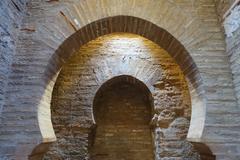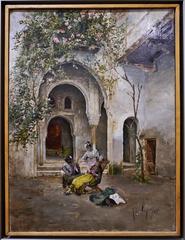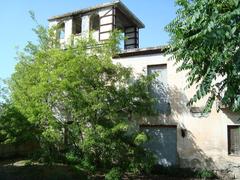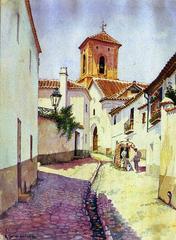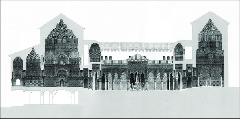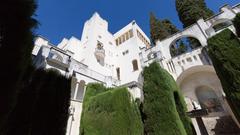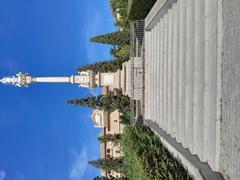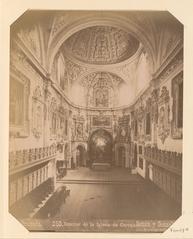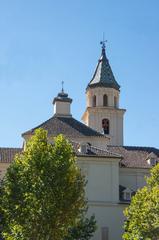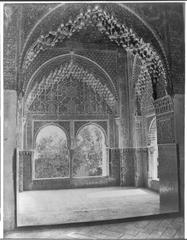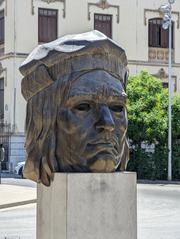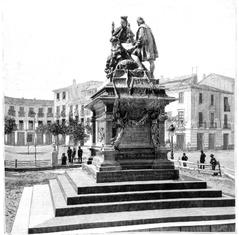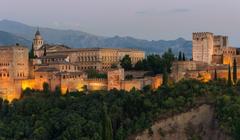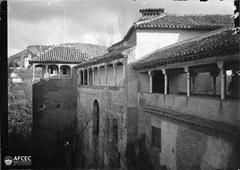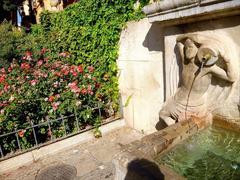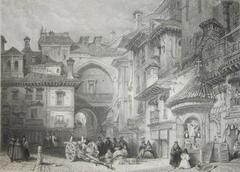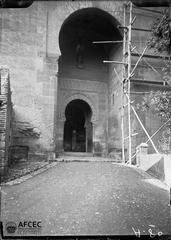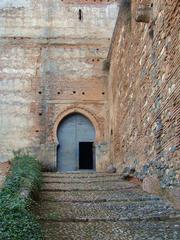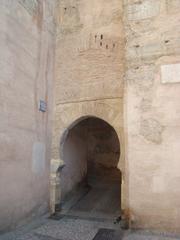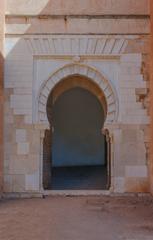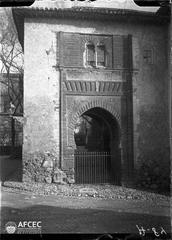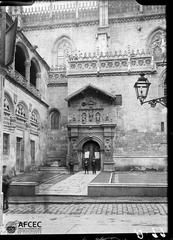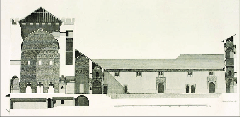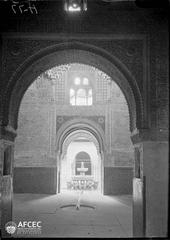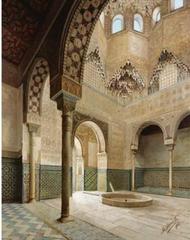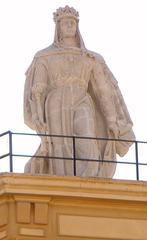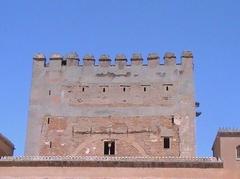
Muralla de la Alcazaba Granada: Visiting Hours, Tickets, and Historical Sites Guide
Date: 04/07/2025
Introduction
The Muralla de la Alcazaba, the oldest and most formidable section of Granada’s Alhambra complex, stands as a testament to centuries of military ingenuity and cultural fusion. Strategically perched atop Sabika Hill, this iconic fortress has served as a military stronghold, royal residence, and enduring symbol of power since the 9th century. Its evolution—from Zirid and Nasrid foundations to post-Reconquista modifications—mirrors the dynamic history that shaped Granada and Spain. Today, visitors are treated to an immersive journey through medieval Islamic military architecture, urban life, and breathtaking panoramic views of Granada, the Albaicín, and the Sierra Nevada mountains.
This guide provides essential information for planning your visit to the Muralla de la Alcazaba, including its historical context, architectural highlights, visiting hours, ticketing, accessibility, travel tips, nearby attractions, and answers to common questions. Whether you are a history enthusiast or a traveler seeking stunning vistas, this resource equips you for a memorable experience at one of Granada’s most treasured historical sites. For official and up-to-date details, consult the Alhambra official website, Guías Granada, and Alhambra Online.
Historical Overview
Early Origins and Strategic Significance
The site of the Alcazaba has been a defensive position since the 9th century, originally home to a fortress known as Ġarnāṭa. In the 11th century, the Zirid dynasty established Granada as their kingdom’s center, building citadels that laid the foundation for the later Nasrid fortress.
Nasrid Dynasty and Construction
The Alcazaba, as seen today, was constructed primarily after 1238 by Muhammad I Ibn al-Ahmar, founder of the Nasrid dynasty. The fortress features a triangular layout with prominent towers, including the Torre de la Vela, Torre del Homenaje, and Torre Quebrada, blending defensive and residential functions.
Medieval Significance and Military Role
Throughout the 12th and 13th centuries, the Alcazaba played a pivotal role in Granada’s defense, reinforced by successive rulers and expanded to include new towers and stronger fortifications. It became the heart of Granada’s military and political power during the Nasrid era.
The Christian Conquest and Transformation
On January 2, 1492, with the surrender of Granada to Ferdinand and Isabella, the Christian flag was raised over the Torre de la Vela, marking the end of Muslim rule in Spain. Subsequent modifications adapted the fortress to withstand artillery, thickening its walls and reinforcing its towers.
Architectural Features
- Torre de la Vela: The tallest and most iconic tower, offering panoramic views of Granada. Its bell, added after the Reconquista, became a symbol of the city.
- Torre del Homenaje: The main keep, which was expanded during the Christian era.
- Torre Quebrada: A defensive tower enhancing the fortress’s main entrance.
- Adarves (Walkways): Elevated battlements providing defensive positions and spectacular vistas.
- Medina: The internal area, once home to residences, workshops, baths, and cisterns, reflecting daily life in the fortress.
The Alcazaba’s architecture combines military might with urban functionality, designed for both defense and self-sufficiency during sieges (Guías Granada, Alhambra Online).
Visiting Information
Visiting Hours
- April 1 – October 14: 8:30 AM – 8:00 PM (daytime); 10:00 PM – 11:30 PM (evening, Tuesday–Saturday)
- October 15 – March 31: 8:30 AM – 6:00 PM (daytime); 10:00 PM – 11:30 PM (evening, Tuesday–Saturday)
- Closed December 25 and January 1
- Always verify hours on the official Alhambra website
Tickets and Admission
- General Admission: Includes Alcazaba, Nasrid Palaces, and Generalife (~€19.09 as of December 2024)
- Gardens Only or Night Visits: Reduced prices available
- Advance Booking: Highly recommended due to high demand—purchase online from the official ticket office
Entry Points
- Pre-booked ticket holders: Enter via the Gate of Justice (Puerta de la Justicia)
- On-site ticket buyers: Use the Entrance Pavilion
Accessibility
- Some accessible facilities, including adapted restrooms at main entrances
- Many areas have stairs and uneven terrain; full accessibility is limited
- Ongoing improvements seek to enhance access, including new park pathways along the Zirí wall
Travel Tips
- Best Times: Early morning or late afternoon for fewer crowds and the best light
- What to Bring: Comfortable footwear, sun protection, water, and a camera
- Navigation: Download a map or use an app for better orientation
- Facilities: Restrooms available at main entrance; no food services inside the Alcazaba
Guided Tours and Enhanced Visitor Experience
- Guided tours (in multiple languages) provide deeper historical context and often include the entire Alhambra complex
- Audio guides and mobile apps available for self-guided exploration
- Occasional special events and exhibitions offer access to lesser-known areas
Nearby Attractions
- Nasrid Palaces: Marvelous Moorish architecture and intricate decorations
- Generalife Gardens: Historic royal gardens adjacent to the Alhambra
- Albaicín Neighborhood: Winding Moorish streets and the famous Mirador de San Nicolás
- Royal Chapel and Palace of Dar al-Horra: Nearby historic sites worth visiting
Practical Tips
- Wear layers for changing temperatures
- Bags larger than 40×40 cm not allowed (free left-luggage service at ticket pavilion)
- Tripods and selfie sticks are prohibited inside enclosed spaces
- Exercise caution on steep steps and exposed heights
Frequently Asked Questions (FAQ)
Are Alcazaba tickets included in Alhambra admission?
Yes; general admission grants access to the Alcazaba, Nasrid Palaces, and Generalife.
Is the Alcazaba accessible for people with reduced mobility?
Some areas are accessible, but many have uneven terrain and stairs.
When is the best time to visit?
Early mornings and late afternoons offer the best experience.
Are guided tours available?
Yes; many tour operators offer guided visits that include the Alcazaba.
Can I bring professional photography equipment?
No tripods, monopods, or selfie sticks are allowed inside enclosed areas.
Visuals and Virtual Tours
For a preview, visit the official Alhambra website for interactive maps and virtual tours. High-quality images of the Alcazaba’s towers and ramparts, especially the Torre de la Vela, capture its grandeur and provide inspiration for your visit.
Related Articles
- “Exploring the Nasrid Palaces of Alhambra”
- “Top Things to Do in Granada”
- “A Traveler’s Guide to the Generalife Gardens”
Conclusion and Recommendations
The Muralla de la Alcazaba stands as a powerful symbol of Granada’s layered history and cultural richness. By planning your visit with attention to ticketing, hours, accessibility, and travel tips, you’ll be able to fully appreciate its architectural marvels and panoramic vistas. Don’t miss the opportunity to explore nearby attractions for a comprehensive cultural journey through Granada. For authoritative information and real-time updates, consult the official Alhambra ticketing site, Guías Granada, and Granada Info.
Ready to explore? Book your tickets, prepare for an enriching experience, and consider using the Audiala app for the latest guides and interactive content. Follow our channels for more travel inspiration and up-to-date tips.
References
- Muralla De La Alcazaba Visitor Guide: Visiting Hours, Tickets, and Historical Insights, 2024, Guías Granada (guiasgranada.com)
- Visiting the Alcazaba of the Alhambra: History, Tickets, and Travel Tips, 2024, Alhambra Online (alhambraonline.org)
- Alcazaba Visiting Hours, Tickets, and Guide to Granada’s Historic Fortress, 2024, Official Alhambra Website (alhambra-patronato.es/en/)
- Muralla de la Alcazaba Visiting Hours, Tickets, and Guide to Granada Historical Sites, 2024, Granada Info (en.granada.info)



